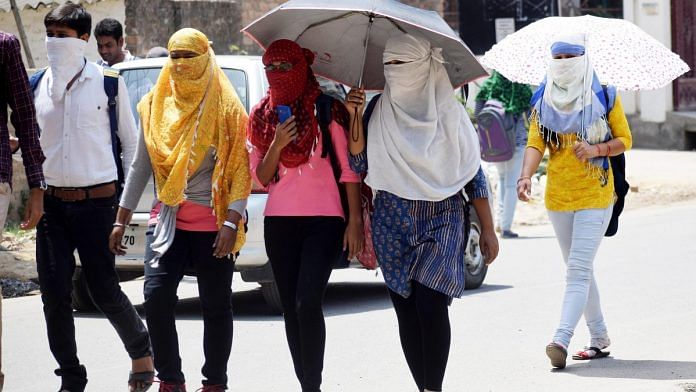New Delhi: Death rates due to heatwaves have increased by 62 per cent in the last 20 years in India, a new study has found.
The study, by the Ministry of Earth Sciences and the India Meteorological Department (IMD), noted that while the number of mortalities per event had reduced for heatwaves in the past 50 years, the overall mortality rate for heatwaves had increased by 62.2 per cent in the last 20 years due to their frequency, which are a direct result of climate change.
For the study, researchers, including Madhavan Nair Rajeevan, Secretary of Ministry of Earth Sciences, analysed IMD’s data from 1970 to 2019 to look at the mortality rates of different extreme weather events such as floods, tropical cyclones, heat waves, cold waves, lightning and others.
The analysis was done both at state and national levels based on different periods — annual, decadal and 20-year slice periods.
The study, published in the Weather and Climate Extremes journal, found that the overall mortality due to extreme events has gone down, primarily because India made significant progress in predicting tropical cyclones in the last 50 years.
Over the decades, despite a significant rise in extreme weather events, there has been a decrease in the mortality rate by 44.6 per cent. Mortality rate in this study is defined as deaths per year per million population.
Also read: Extreme heat events have arrived earlier than feared, climate study finds
Govt worked on tropical cyclones but heatwaves remain worry
While the overarching data from this study seems promising, looking at the different extreme weather events individually paints a much clearer picture.
The study found that out of all extreme weather events, floods accounted for maximum mortality of 46.1 per cent, followed by tropical cyclones with 28.6 per cent mortality.
The mortality rate of tropical cyclones also reduced by 94 per cent in the past 20 years.
“The government has done a lot of good work in understanding cyclones and preventing mortalities using coastal warning systems. There has been a lot of progress made in predicting cyclones. That is why mortality associated with tropical cyclones have gone down,” A.P. Dimri, a professor at JNU and one of the authors of the study, told ThePrint.
He added: “Heatwaves and lightning events are increasing due to climate change. However, the systems to prevent deaths from such events have not been implemented to that scale,”
Therefore, due to the significant progress made in reducing deaths during tropical cyclone events, the overall mortality rate for extreme weather events went down from 3.86 during 1980–1999 to 2.14 during 2000–2019.
In India, Odisha, Andhra Pradesh, Assam, Bihar, Kerala, and Maharashtra had the maximum mortality rates due to extreme weather events in the last two decades.
Andhra Pradesh has the highest overall mortality rate due to extreme events — nearly 4.5 deaths per million per year.
In the study, the researchers noted that there is a need to consider these states with priority for developing disaster management action plans.
In 2019, India experienced 73 heatwave spells against a normal of 17 (based on the average during 1986–2016). Meanwhile, during the second half of the monsoon season, excess rainfall led to floods in central parts of India.
Also, a total of 11 tropical cyclones developed over the north Indian Ocean, as opposed to a normal of two. The year ended with extreme cold wave spells over northern India during December.
The annual averages of extreme weather events have been increasing continuously in the past 50 years. Previous studies showed that the decade 2007–2016 reported an increase of 18 per cent of annual extreme weather events as compared to the earlier decade (1997–2006).
A 2006 study pointed out that there is a significant rising trend in the frequency and magnitude of extreme rain events over central India during 1951–2000.
This also contributed to an increase in the total seasonal rainfall of the Indian summer monsoon.
Also read: Intensive irrigation has worsened lethal ‘moist heat stress’ in India, IIT study finds



